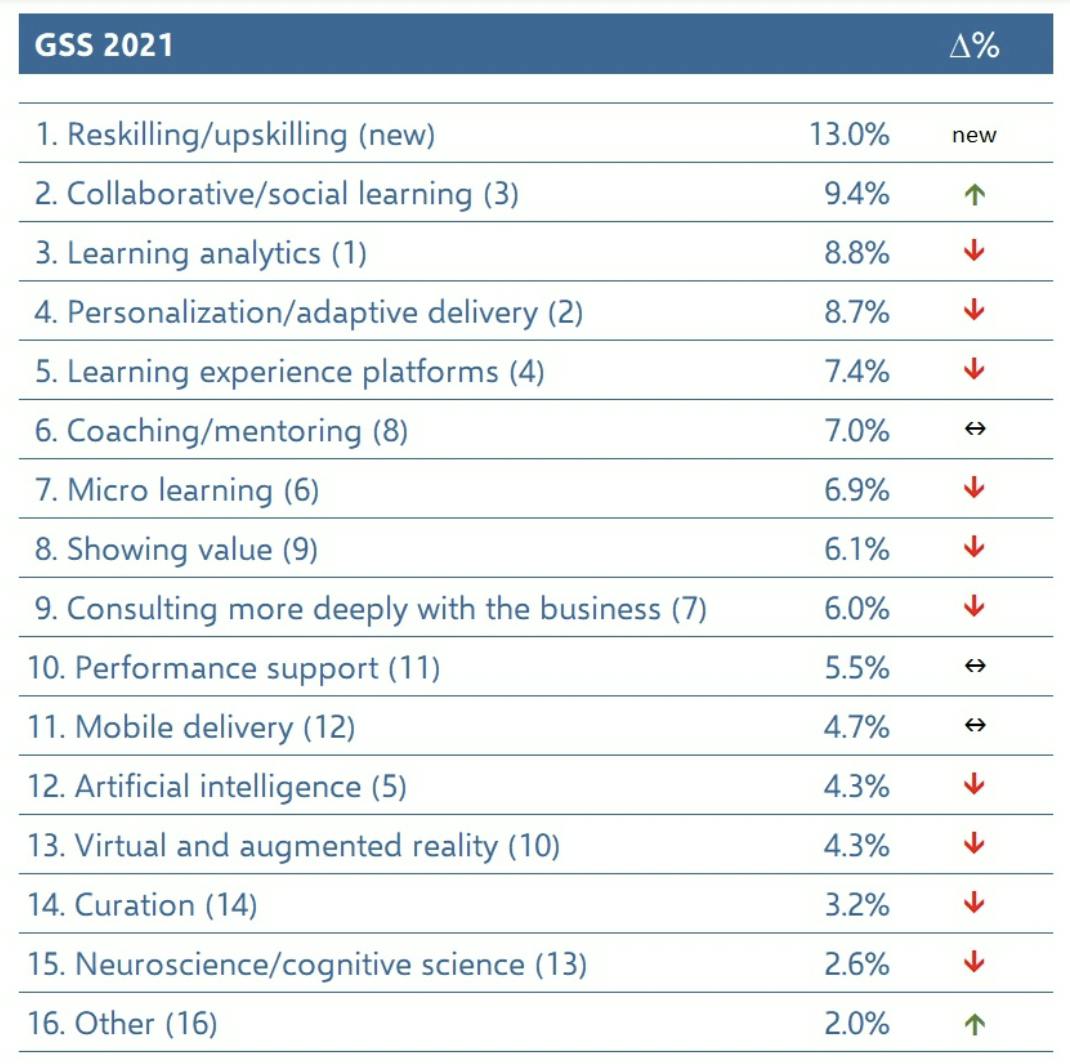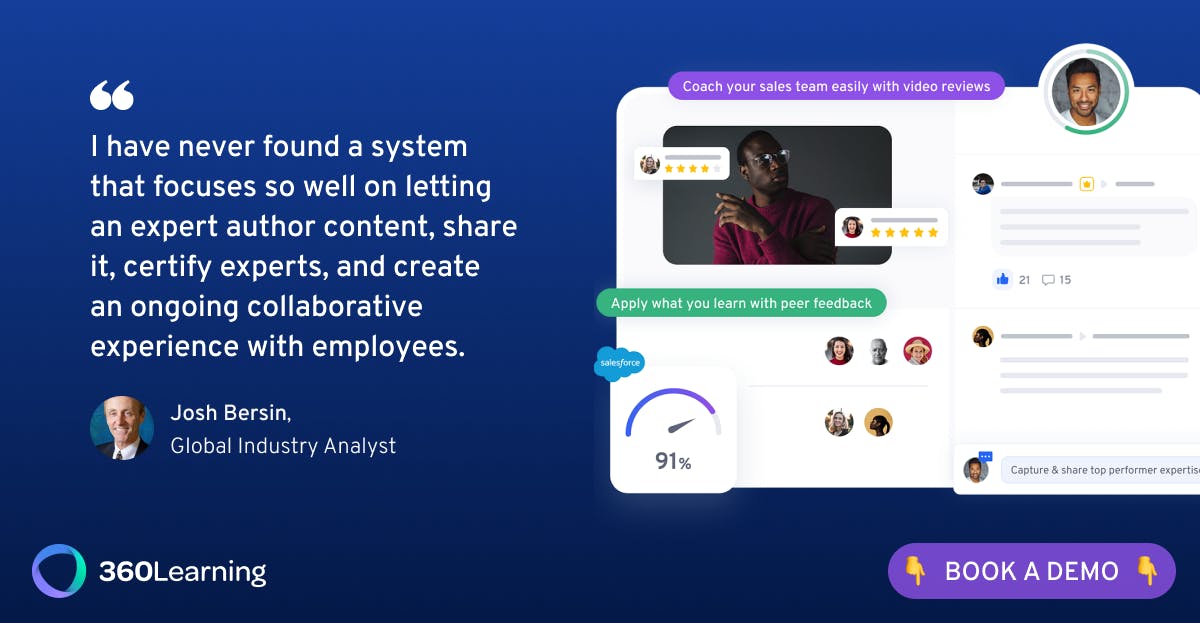
What are the Top Learning Priorities for 2021, According to Over 3,000 L&D Leaders?
Right now, the world is living through huge changes in the way we work. Between COVID-19 and the shift to remote working, 2020 represented a great reset; now, L&D teams are in the driver’s seat, and are figuring out what these shifts mean for the way we learn and grow at work.
With all this turmoil, it’s no surprise that the results of the Learning Performance Institute’s 2021 Global Sentiment Survey are unlike any other. We’ve found some fascinating shifts here, including Collaborative Learning being seen by L&D leaders as a top priority for 2021.
Here are our key takeaways from the survey - and what they mean for you.
Collaborative Learning is a top priority for L&D in 2021
Here are the top priorities for L&D leaders in 2021, according to the Learning Performance Institute’s Global Sentiment Survey:

Of all the priorities, Collaborative Learning is the only one that increased in importance since the 2020 survey. As Chairman of the Learning and Performance Institute Donald H. Taylor explains: “Until recently, collaboration and social learning had seemed ideals - things we probably should be doing, but only embraced by a few organizations.”
As he points out, 2020 and COVID-19 changed all that.
Now, the workforce has shifted online, creating new ways of working. At the same time, the huge uptick in the use of remote collaboration tools such as Slack and Microsoft Teams, as well as online conference tools like Zoom, demonstrated that people can work remotely. In fact, they were already finding new ways to collaborate and learn from each other.
Put simply, says Donald, “last year, collaboration and social learning moved from theoretical to practical, and became super hot.”
This is exciting, but not surprising. We’ve seen firsthand the potential of Collaborative Learning since we pioneered the concept in the workplace in 2015. For the last six years, we’ve been working with over 1,200 clients to make decentralized peer-driven learning a reality, with our share of awards to show for it.
So, why exactly is Collaborative Learning gaining so much momentum right now?
Last year, collaboration and social learning moved from theoretical to practical, and became super hot.
Why Collaborative Learning is gaining so much momentum
It isn’t hard to see why Collaborative Learning has increased in popularity. With 55% of U.S. executives expecting to offer working-from-home options in 2021, and with average course completion rates at only 20-30% across the industry, the old ways of in-person classroom training simply don’t cut it anymore.
Now, teams everywhere need a new - and better - way to declare learning needs, share their subject-matter expertise, and collaborate seamlessly to develop training content. They need a way to capture and hold people’s attention, and make learning exciting again.
Collaborative Learning offers a great solution to this challenge. That’s because:
- Collaborative Learning is nimble. With the right platform leveraging Collaborative Learning, businesses can create courses in minutes, not months. This isn’t just a quicker way of responding to learning needs; it’s also much more cost-effective.
- Collaborative Learning is people-centric: Collaborative Learning recognizes that people are a company’s most valuable resource. Employees can declare learning needs, and in-house experts can meet those needs by creating relevant courses.
- Collaborative learning is distributed. People are happiest when they can take control of their learning environment, contribute their skills and experience by creating content, and have their contributions valued by their peers. This way, people want to learn, and L&D teams don’t have to spend so long chasing them down to complete activities.
But as we noticed from the LinkedIn discussion following the announcement of the L&D Global Sentiment survey, a lot of L&D professionals had one big question about Collaborative Learning: how can you measure results?
5 ways to make sure Collaborative Learning isn’t all talk and no substance
In a competitive climate, every dollar spent needs to be justified. Trust us - we get it.
We can understand how measuring the results of a switch to Collaborative Learning may seem like a tall order. In reality, measuring these results isn’t such a big deal after all - providing you have a clear framework.
Here are five great ways to measure the impacts of Collaborative Learning, based on our experience supporting industry leaders like AlphaSights.
1. Engagement and completion rates
Course engagement and completion rates are a classic metric showing the performance of your L&D programs. Collaborative Learning is no different - you can still track these metrics to compare how well your programs are engaging learners.
For example, after industry research platform AlphaSights switched to its Collaborative Learning program, it launched an average of 27 new courses per month while maintaining a 95% completion rate - far above the industry average of 20-30%.
On top of learner engagement, you can also track the number of employees contributing to training programs. For example, AlphaSights found that 27% of people were offering their own expertise and knowledge to help their colleagues learn.
2. Learner sentiment
Beyond simple completion metrics, a Collaborative Learning platform can also track learner sentiment towards specific courses. That’s because learners can respond to each program - and even each page - to let course creators know how they feel and offer areas for improvement.
Once again, AlphaSights offers a great example, with an incredible 99% learner satisfaction rating following the introduction of their new onboarding program.
3. Activity completions
With Collaborative Learning, L&D leaders can encourage teams to think of learning not just as a one-off annual box-ticking exercise, but a daily activity. That’s why tracking the number of activities completed by learners can give such a clear idea of the positive impacts.
Our clients use 360Learning to support their learners to complete an average of 11 daily activities per user. This way, people never stop growing their skills and capabilities.
4. Ramp-up time
Growing organizations need new hires to get up to speed as quickly as possible - that’s why reducing ramp-up time is so key. This is another area where Collaborative Learning can make a huge impact.
5. Cost of delivering training programs
On top of tracking learner completions and sentiment, organizations can also track the amount of money they’re saving by switching. For executives who might still be on the fence, these figures offer all the reassurance you’ll need.
When compared with a standard LMS, all of these advantages really add up:

Come and see what Collaborative Learning can do for you
We’re thrilled to see how many L&D leaders are interested in Collaborative Learning right now. In 2021 and beyond, the movement is going to grow even more.
As more leading startups and innovators like AlphaSights switch to Collaborative Learning, we’re hoping to see traditional top-down approaches to learning become a distant memory. Instead, we want decentralized and distributed learning to become the norm.
We started applying Collaborative Learning to organizational culture years ago. Now, we want to show you what it can do for your business.
Want to find out more about how Collaborative Learning with our intuitive platform can help you and your teams? Book a free demo with one of our learning experts today!


